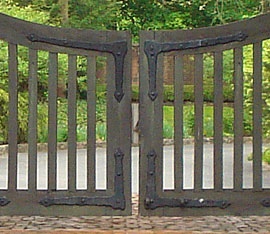You have put a lot of time and effort into just the right design for your outdoor improvement, and selecting the right materials. And deciding on the right contractor is just as important. Here are some basic steps to follow when hiring a contractor:

An experienced local deck contractor was hired to build this deck
Get Recommendations from Reliable Sources:
The best sources to find a contractor that has the required skills needed for your renovation project is from people you know who have used a particular contractor, your local Chamber of Commerce, your local building department, and the product manufacturer or the building material distributor. Get at least 3 contractors names and have them review your construction drawings.
Experience & Skill:
You want to hire a contractor who has the skills, years of experience, and know-how for the project you want to hire them to do. Ask the contractor what their experience is with your type of project, and the building materials that will be used to build it. You don’t want to hire a contractor to build your deck if the contractor has never built a deck.
References:
Ask the contractor for several references. Check the references to see if the project was –
- completed per the construction drawings
- to the required level of craftsmanship
- completed in a timely manner
- completed for the agreed upon cost
- and if the contractor was easy to work with
Also, check the BBB (Better Business Bureau) to see if the contractor is a member. This will tell you how long the contractor has been in business, if there have been any complaints filed against the contractor, and how responsive the contractor was in resolve any problems. Reliable contractors do exist; it’s just a matter of sifting through the crowd to find them. We know of many reliable contractors who will make things right if there is a problem, because their reputation is at stake.
Insurance:
Ask the contractor if they are licensed and if they carry liability insurance and workman’s compensation.
A licensed contractor means the contractor is licensed with the state that they are in and are capable of completing the specified work. Not every state requires a contractor license. To find out if your state requires a contractor to be licensed check out this link http://www.contractors-license.org/.
Liability insurance is insurance for property damage or personal injury claims that could occur on your property. If either/both incidents occurs anytime during the duration of the entire project due to the contractor’s work and the contractor does not carry liability insurance, you could end up paying the claims out of your homeowners insurance.
Workmen’s compensation is a form of insurance for the contractor’s employees. It covers wages and medical expenses if the contractor’s employee is injured on the job.
Estimate:
Get a written estimate that includes all labor and materials. This will insure that you and the contractor understand the scope of the project and can eliminate any confusion that could result in a contract change during the project. A contract change usually means more money out of your pocket. Also, when comparing estimates, make sure that each contractor has specified the exact materials you want used for your project. Be aware of unusually low estimates. A price that is too good to be true is just that – Too Good To Be True! However, if you as a homeowner decide to add or subtracts an item from the original scope of work due to budget issues or you change your mind on, for example a material selection, once the construction of your project has begin, then the contractor should issue a change order and give you a copy for your record.

To build this brick entry walk, pallets of brick, piles of gravel and sand where delivered to this home. These materials were placed in an area that did not interfere with the use of the driveway
Reduce Inconveniences:
Ask the contractor if there will be any interruptions in utility services and how long they will be turned off. Also, if materials are being delivered, agree on a location on your property for storage, so it doesn’t interfere with your daily routine, like you being able to use your driveway/garage.
Schedule:
Get a written timeline for the completion of the project, from start to finish. This will include a start date and a completion date. If the contractor needs to arrange for material delivery for your project, make sure you know when the material will be delivered. The contractor can’t start without the necessary materials. Also, ask about the contractors’ policy on weather delays.
Zoning and Building Code:
In the planning stage of any outdoor home improvement project, check with your local building department to make sure that the project you want to do is in compliance with your local zoning code and building code. Also, if your project is allowed, make sure all building code requirements are met and that you comply with the required setbacks and easements. If setback and easement requirements are not met, your building department will require you to remove any portion of your improvement that encroaches into the setback and easement, which is a very costly mistake. It is always a safe practice to have a professional survey done to locate your property lines, setbacks, and easements before construction begins.
Permits and Inspections:
Check your local building department to see if there are any permit and inspection requirements for your project. You may be required to submit drawings of your project to your local building department in order to get the permit. It is important to get the required permits before your project begins so you will not have any surprises later. Without required building permits, your local building department will stop your project. Ask if the contractor will be getting the required permits. If that is not part of the service they provide, then you will need to acquire the permits yourself.
Do not hire a contractor that does not think permits are necessary. This should send up a red flag and is a good indicator that this contractor is not the right one for you. Also, make sure all required inspections are being completed during the project and at the end of the project.
Payment:
It is not wise to pay a contractor the full amount of the construction cost. Set up a payment schedule with the contractor for labor and materials, for the contractor to receive payments over the timeline of the project, from start to finish. Some states have laws that require a small specific percentage to be paid to the contractor at the start of a project for project materials to be purchased. If this is a requirement in your state, have the contractor submit an invoice to you so there is a record of this start-up payment. Make sure the contractor submits an invoice for each request for payment from you throughout the duration of the project , with a list of what the request for payment covers. The final invoice for your project gives you the opportunity to do a final walk-through to review your project to make sure that all of the work has been completed per the construction drawings and contract and that you are happy with the results. If there is any part of the project that was not completed under the contract you agreed to with your contractor, you can withhold final payment until the contractor completes the work.
Also, if your project requires inspections by your local building department, make sure all inspections have been completed. It is the contractor’s responsibility to comply with the city’s inspection, and the project is not complete until all issues have been addressed and the contract has been satisfied. It is not wise to pay the final payment to your contractor until your local building department has made their final inspection. Also, ask for documentation from your contractor that all suppliers and subcontractors have been paid in full.
























